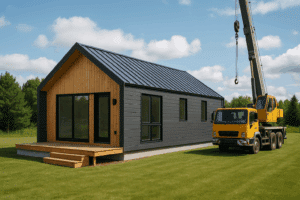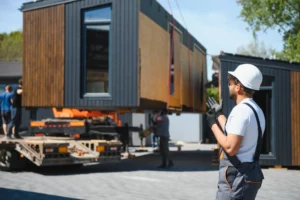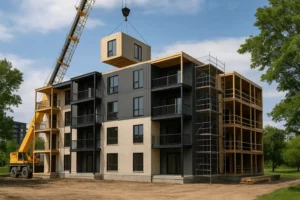The housing crisis in Quebec is reaching alarming proportions. With rising real estate prices and a shortage of affordable housing, many Quebecers find themselves in a precarious situation.
However, there is an innovative and effective solution: prefabricated homes. These homes, built in a factory and assembled on site, offer numerous advantages in terms of cost, construction time, and quality.
What is a prefabricated house?
Prefabricated homes are dwellings whose components are manufactured in a factory using standardized production methods before being transported and assembled at the final site.
This method ensures high construction quality, reduced lead times and costs, and flexibility in design.
Advantages of prefabricated homes
Affordable cost
Prefabricated homes are generally less expensive than traditional homes. This cost reduction is due to the efficiency of factory manufacturing processes, which optimize material use and reduce waste.
- According to a study by the Société d'habitation du Québec (SHQ), factory prefabrication has reduced construction costs for 50% in certain pilot projects compared to traditional methods. (The Press, 2024)
Quick construction
Factory construction significantly reduces the time it takes to have a house ready for occupancy. The various parts of the house are manufactured in parallel and then quickly assembled on site, which can reduce lead times by several months.
- The SHQ indicated that the use of prefabricated modules makes it possible to speed up the construction sites of 30%, making possible the rapid delivery of housing. (The Press, 2024)
Quality and durability
Prefabricated homes are built to strict standards, ensuring high quality and long-term durability. Each component is manufactured in a controlled environment, protected from the elements, improving assembly precision and quality.
Factory construction allows in particular:
- Rigorous Quality Control : Factory manufacturing processes allow for quality inspections at every stage, ensuring that every part meets the highest standards.
- Optimal Working Conditions : Unlike traditional construction sites, factories offer stable conditions, protected from climatic variations, which reduces construction defects and errors.
- Efficient Use of Materials : Standardized construction techniques and precision tools improve efficiency and consistency, reducing waste and quality variation.
- Advanced Technology : The use of modern technologies such as CNC cutting systems and assembly robots increases accuracy and reduces the margins of human error.
Find out more about prefabricated units and their strengths in our article: The advantages of prefabricated houses in 2024.
Design flexibility
Prefabricated homes offer a wide variety of models and designs to suit individual needs and tastes. Thanks to their modular design, these homes can be customized to suit buyers' preferences, offering flexibility that rivals traditional construction.
Using modular design principles, prefabs allow:
- Easy Customization : The modular design allows you to choose from various pre-defined modules, such as kitchens, bathrooms, or extensions, which can be combined to create a unique design.
- Adaptability : Modules can be added, removed or modified easily, allowing homeowners to adapt their home to their changing needs over time.
- Design Options Buyers can choose from a range of architectural styles, materials and finishes, ensuring the home reflects their personal tastes.
- Speed of Modification : Modifications and additions can be made quickly and with less disruption compared to traditional construction, thanks to factory manufacturing and on-site assembly.
The flexibility of modular design not only allows for meeting homeowners' current needs, but also for anticipating their future needs, making prefabricated homes extremely adaptable and customizable.
It also facilitates expansions and renovations, allowing owners to easily add new modules or modify existing modules without requiring major reconstruction.
This modularity offers great freedom in the evolution of the house, ensuring that it can adapt to changes in lifestyle and new family requirements over time.
Prefabricated buildings: A sustainable solution
Reducing waste
Factory construction significantly reduces material waste. Standardized manufacturing processes and modular design allow for more efficient use of materials and minimize waste. This also reduces the environmental footprint of construction.
Standardized working methods
Standardized factory working methods ensure consistent quality and reduce errors. Every stage of construction is monitored and optimized, improving efficiency and reducing costs.
Modular design
The modular design of prefabricated homes allows for faster and more efficient assembly of individual parts. The modules are prefabricated in a factory and assembled on site, speeding up the construction process and reducing labor costs.
Various options allow homes to be customized to suit homeowners' needs, making it easier to add additional rooms, modify interior layouts, and incorporate new technologies or eco-friendly solutions, while minimizing the disruption and costs associated with traditional renovations.
Immigration plays a dual role in addressing the housing crisis. On the one hand, the arrival of new residents in Quebec increases the demand for housing, exacerbating the existing crisis.
On the other hand, immigration helps fill labor shortages, particularly in the construction sector, which can help accelerate the construction of new homes, including prefabricated homes.
Increased demand for housing
The influx of immigrants increases the population and, consequently, the demand for housing. This increased demand puts additional pressure on an already tight real estate market, making the housing crisis even more complex.
Labor shortage
At the same time, Quebec is facing a labor shortage in several sectors, including construction. Immigrants can help fill these vacant positions, thereby accelerating the construction of new housing. However, integrating this workforce requires additional efforts in terms of training and support.
How prefabricated homes can help the housing crisis
Increase in housing supply
Prefabricated homes can be built quickly, increasing the housing supply in a short time. This speed of construction allows for rapid response to growing housing demand.
Financial accessibility
Their affordable cost allows more families to become homeowners. Cost savings from factory production and reduced construction times translate into lower selling prices.
Social housing projects
Prefabricated homes can be used in social housing projects to provide quick, high-quality solutions to those in need. Their rapid construction speed and low cost make them an ideal option for addressing housing emergencies.
Conclusion
Faced with the housing crisis in Quebec, prefabricated homes are emerging as a viable and innovative solution. They offer an affordable, quick-to-build, and sustainable alternative to meet growing housing needs.
Thanks to their factory production, they help control costs and delivery times, while reducing waste and the environmental footprint. By combining this solution with effective immigration and workforce management, Quebec can overcome the complex challenges of the housing crisis.
To discover more prefabricated home models available in Quebec, visit our prefabricated house search platform. Explore our many options and find the home that fits your needs and budget.
Discover how prefabricated homes offer a fast, affordable, and sustainable solution to Quebec's housing crisis. Visit our platform to explore a variety of available models.




